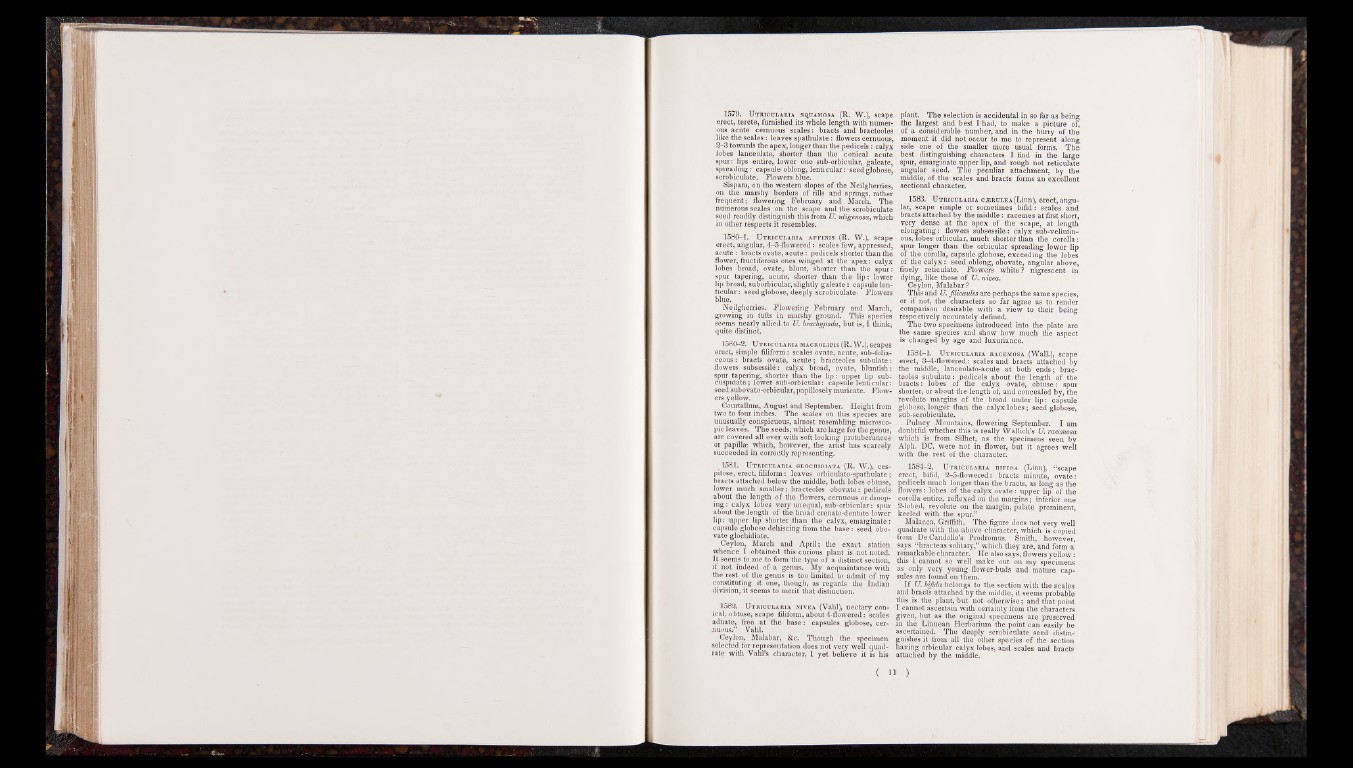
1579. Utricularia squamosa (R. W.), scape
erect, terete, furnished its whole length with numerous
acute cernuous scales: bracts and bracteoles
like the scales: leaves spathulate: flowers cernuous,
2-3 towards the apex, longer than the pedicels: calyx
lobes lanceolate, shorter than the conical acute
spur: lips entire, lower one sub-orbicular, galeate,
spreading: capsule oblong, lenticular: seed globose,
scrobiculate. Flowers blue.
Sispara, on the western slopes of the Neilgherries,
on the marshy borders of rills and springs, rather
frequent; flowering February and March. The
numerous scales on the scape and the scrobiculate
seed readily distinguish this from U. uligenosa, which
in other respects it resembles.
1580-1. Utricularia affinis (R. W.), scape
erect, angular, 4-5-flowered: scales few, appressed,
acute: bracts ovate, acute: pedicels shorter than the
flower, fructiferous ones winged at the apex: calyx
lobes broad, ovate, blunt, shorter than the spur:
spur tapering, acute, shorter than the lip : lower
lip broad, suborbicular, slightly galeate: capsule lenticular
: seed globose, deeply scrobiculate. Flowers
blue.
Neilgherries. Flowering February and March,
growing in tufts in marshy ground. This species
seems nearly allied to U. brachypoda, but is, I think,
quite distinct.
1580-2. Utricularia macrolipis (R. W.), scapes
erect, simple filiform: scales ovate, acute, sub-folia-
ceous: bracts ovate, acute; bracteoles subulate:
flowers subsessile: calyx broad, ovate, bluntish:
spur tapering, shorter than the lip : upper lip sub-
cuspidate; lower sub-orbicular:, capsule lenticular:
seed subovato-orbicular, papillosely muricate. Flowers
yellow.
Courtallum, August and September. Height from
two to four inches. The scales on this species are
unusually conspicuous, almost resembling microscopic
leaves. The seeds, which are large for the genus,
are covered all over with soft looking protuberances
or papillas which, however, the artist has scarcely
succeeded in correctly representing.
1581. Utricularia glochidiata (R. W.), ces-
pitose, erect, filiform: leaves orbiculato-spathulate ;
bracts attached below the middle, both lobes obtuse,
lower much smaller; bracteoles obovate: pedicels
about the length of the flowers, cernuous or drooping:
calyx lobes very unequal, sub-orbicular: spur
about the length of the broad crenato-dentate lower
lip: upper lip' shorter than the calyx, emarginate:
capsule globose dehiscing from the base: seed obovate
glochidiate.
Ceylon, March and April; the exact station
whence I obtained this curious plant is not noted.
It seems to me to form the type of a distinct section,
if not indeed of a genus. My acquaintance with
the rest of the genus is too limited to admit of my
constituting it one, though, as regards the Indian
division, it seems to merit that distinction.
1582. Utricularia nivea (Vahl), nectary conical,
obtuse, scape filiform, about 4-flowered: scales
adnate, free at the base: capsules globose, cernuous.”
Vahl.
Ceylon, Malabar, &c. Though the specimen
selected for representation does not very well quadrate
with Vahl’s character, I yet believe it is his
plant. The selection is accidental in so far as being
the largest and best I had, to make a picture of,
of a considerable number, and in the hurry of the
moment it did not occur to me to represent along
side one of the smaller more usual forms. The
best distinguishing characters I find in the large
spur, emarginate upper lip, and rough not reticulate
angular seed. The peculiar attachment, by the
middle, of the scales and bracts forms an excellent
sectional character.
1583. Utricularia c^ rulea (Linn), erect, angular,
scape simple or sometimes bifid: scales and
bracts attached by the m iddle: racemes at first short,
very dense at the apex of the scape, at length
elongating: flowers subsessile: calyx sub-vellutin-
ous, lobes orbicular, much shorter than the corolla:
spur longer than the orbicular spreading lower lip
of the corolla, capsule globose, exceeding the lobes
of the calyx: seed oblong, obovate, angular above,
finely reticulate. Flowers white P nigrescent in
dying, like those of U. nivea.
Ceylon, Malabar ?
This and U. Jilicaules are perhaps the same species,
or if not, the characters so far agree as to render
comparison desirable with a view to their being
respectively accurately defined.
The two specimens introduced into the plate are
the same species and show how much the aspect
is changed by age and luxuriance.
1584-1. Utricularia racemosa (Wall.), scape
erect, 3-4-flowered: scales and bracts attached by
the middle, lanceolato-acute at both ends; bracteoles
su b u la te : pedicels about the length of the
bracts: lobes of the calyx ovate, obtuse: spur
shorter, or about the length of, and concealed by, the
revolute margins of the broad under lip : capsule
globose, longer than the calyx lob es; seed globose,
sub-scrobiculate.
Pulney Mountains, flowering September. I am
doubtful whether this is really Wallich’s IT". racemosa
which is from Silhet, as the specimens seen by
Alph. DC. were not in flower, but it agrees well
with the rest of the character.
1584-2. Utricularia bifida (Linn), “scape
erect, bifid, 2-5-flowered: bracts minute, ovate:
pedicels much longer than the bracts, as long as the
flowers: lobes of the calyx ovate: upper lip of the
corolla entire, reflexed on the margins; inferior one
2-lobed, revolute on the margin, palate prominent,
keeled with the spur.”
Malacca, Griffith. The figure does not very well
quadrate with the above character, which is copied
from De Candolle’s Prodromus. Smith, however,
says “bracteas solitary,” which they are, and form a
remarkable character. He also says, flowers y ellow :
this I cannot so well make out on my specimens
as only very young flower-buds and mature capsules
are found on them.
I f U. bifida belongs to the section with the scales
and bracts attached by the middle, it seems probable
this is the plant, but not otherwise; and that point
I cannot ascertain with certainty from the characters
given, but as the original specimens are preserved
in the Linnean Herbarium the point can easily be
ascertained. The deeply scrobiculate seed distinguishes
it from all the other species of the section
having orbicular calyx lobes, and scales and bracts
attached by the middle.
( n )